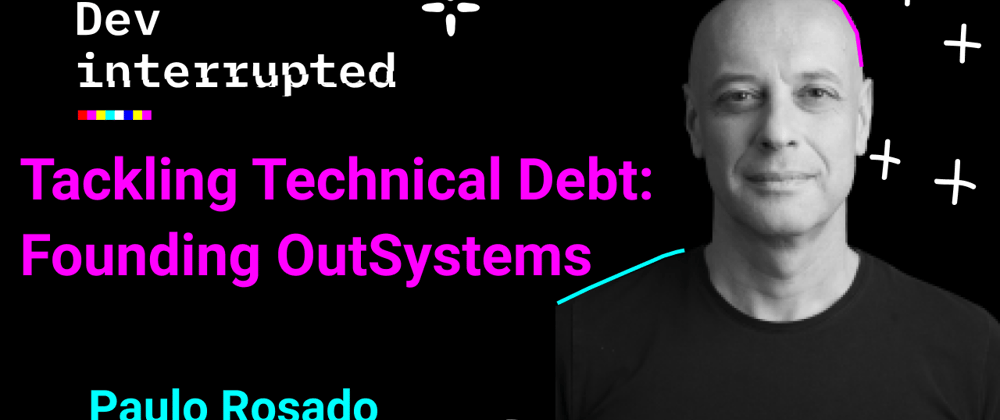Following a recent interview on the Dev Interrupted Podcast, OutSystems CEO and founder Paulo Rosado joined us to chat about his path to founding the company, advice for successful leaders, and the growing threat of technical debt. The conversation below has been edited for length and clarity.
Dan Lines: Tell us about OutSystems' founding story. What inspired you to start the company?
Paulo Rosado: In February 2021, OutSystems was valued at $9.5 billion dollars - but it certainly didn’t start out that way. The idea behind OutSystems was decades in the making, and its mission stems from what I observed after moving to Silicon Valley back in the mid-nineties.
My journey in technology began when I graduated with a degree in computer engineering from Universidade Nova de Lisboa in Lisbon, Portugal and moved to the US to get my Masters in Computer Science from Stanford. Afterward, while working in Silicon Valley, I began to understand just how much of a problem technical debt was.
While working on a very large engineering team, we were faced with tackling a gigantic project in Java and I realized the issues of releasing and maintaining code sustainably. The lack of productivity in the software development process was appalling. Fixing this problem is ultimately what motivated me to found OutSystems.
Before founding OutSystems, there was a small company I founded and later sold, which focused on internet and intranet projects. It wasn’t a bad company, but we kept failing. Projects were never delivered on time or on budget.
We would think to ourselves, “We’re smart. How is this possible?” Our inclination was to blame the requirements of the project, labeling the scope as incorrect and adjust from there. However, we began to realize that the companies hiring us for these projects wanted us to make changes as we were developing in response to rapidly changing environments.
The issue we began to face was the continual accumulation of technical debt. We would reach first production and realize we had built something users didn’t want, requiring us to go back and rework the stuff we had just built.
“We came up with this realization that the problem was not that the requirements up front were wrong. The problem was that the cost of changing wrong requirements, which are a fact of life, is very high.” - on the Dev Interrupted podcast at 6:03
This phenomenon was occurring in 90% of projects at the time. Things were always over budget and always late.
Today, it’s easy to take this for granted because concepts like Agile, DevOps, CI/CD are mainstream. But at the time, you had to build software the same way you build a bridge.
Dan: Why is technical debt a challenge for companies now? How has this problem changed?
Paulo: Technical debt has become a large problem for businesses, and one that only compounds with time. Tech debt doesn’t have a singular cause - it’s the accumulation of several factors.
Over the course of my career, I’ve seen first-hand the complexity brought about by the evolution of software development. For instance, we’ve seen an explosion of languages, paradigms and frameworks that can all be used to achieve a solution. Often these languages are dispersed with no connections between them, so tracking these dependencies requires a great deal of sophistication.
In addition to this, turnover within the development team is a critical problem that leads to technical debt. The moment a company loses a developer, the knowledge accrued by that developer also departs the company. The hole left behind is complex, including code, frameworks and intent behind how their systems are structured.
It’s been my experience that a lost team member can take as much as 20% to 30% of the fundamental knowledge of a system with them. Reverse engineering their work is both time-intensive and inefficient.
Companies have tried to corral this problem by investing in coding standards. While these constraints can help mitigate the loss of a valued developer, our research indicates turnover remains a significant problem.
Dan: OutSystems recently released a study on the effects of technical debt. What were its findings?
Paulo: Recently, OutSystems surveyed 500 large companies around the world to examine the cost of technical debt facing businesses and uncover the challenges companies face as they confront its causes. The results from the companies surveyed were many of the same things I’ve observed throughout my career.
It’s important to note that while the causes of technical debt have largely remained the same, the pace at which technical debt occurs has grown substantially.
“And so it's a hack, right? What we call a hack at OutSystems, they did a hack to just release the software quickly. And those hacks compound into technical debt.” - on the Dev Interrupted podcast at 27:11
The survey we conducted isolated three major causes of technical debt. They are as follows:
- The amount of developer frameworks. An increase in frameworks leads to an increase in technical debt.
- Developer erosion. Employees leaving an organization and taking legacy knowledge with them.
- Compromises in quality of architecture and code. Often caused by a shortsighted view that what needs to be done now is more important than long-term stability of the codebase.
In the past, companies believed they could buy their way out of this problem, but that strategy has proven ineffective. The reality is, the most successful companies must build the software they require to meet their business needs.
Simply purchasing what you need doesn’t solve your problems because even purchased systems must be cobbled together, requiring unique API’s, unique UI’s, unique portals, and unique mobile applications.
Dan: Does OutSystems play a role in helping companies cut tech debt?
Paulo: The core of what we do at OutSystems is focused on tackling those three fundamental problems. We understand that technical debt amasses slowly over time, through a myriad of decisions that appear much smaller at their onset than their totality would suggest. Once these “tiny” decisions become a major problem, they inhibit investment in current operations and future innovations.
The increasing pressures of today’s fast-paced business environment often push companies toward decisions that spiral into technical debt. The good news is that by creating a development process that marries short-term deadlines with long-term strategic goals, it’s possible to “pay down” that debt.
I believe that any company is capable of whittling away technical debt with the correct tools and processes, and I founded OutSystems because companies shouldn’t have to choose between building fast and building right.
To learn more about technical debt, how to combat it, and what to expect in the future, you can download the 2021 Technical Debt Report on our website.
Starved for top-level software engineering content? Need some good tips on how to manage your team? This article is based on an episode of Dev Interrupted - the go-to podcast for engineering leaders.
Dev Interrupted features expert guests from around the world to explore strategy and day-to-day topics ranging from dev team metrics to accelerating delivery. With new guests every week from Google to small startups, the Dev Interrupted Podcast is a fresh look at the world of software engineering and engineering management.
Listen and subscribe on your streaming service of choice today.








Latest comments (4)
Thanks for coming on the podcast Paulo!
Super glad Paulo came on the podcast and shared this article - it's inspiring to see the results of his journey and how he's overcome challenges.
Can't wait to see how OutSystems continues to tackle technical debt!
Very interesting guy. He's clearly a man with a billion(s) dollar vision!
The results of Outsystems' study are very interesting. It was very nice for Paulo to com on the podcast!